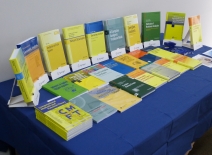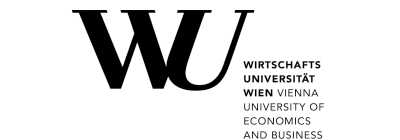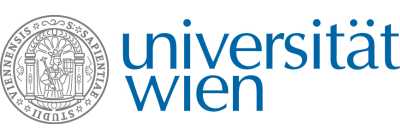News
2020-03-05: Links to slides and fotos
The links to slides and photos which were sent (together with the necessary passwords) to participants in September [subject "VCMF 2019: News (slides, confirmations/CPD, photos, participants, thanks)"] were valid only a limited period (and could not be activated again). Due to a request new links were generated:
- Slides
of all speakers who accepted to share the slides with participants (e.g., uploaded slides after the event):
- Photos
of the social events (you can download whole folders or single files but it is no photo gallery where you can scroll through the photos):
2019-09-10 (c): Conference Dinner

 The Conference Dinner today evening (Tuesday, Sept. 10) will take place in the Vienna City Hall (Wiener Rathaus). In the spectacular Festival Hall we will have a delicious dinner as well as a dancing lesson (from quadrille to Viennese waltz). The Conference Dinner is included for all participants.
The Conference Dinner today evening (Tuesday, Sept. 10) will take place in the Vienna City Hall (Wiener Rathaus). In the spectacular Festival Hall we will have a delicious dinner as well as a dancing lesson (from quadrille to Viennese waltz). The Conference Dinner is included for all participants.
For participants of the conference & accompanying persons:
please do not forget to bring the voucher(s) with you.
For participants of the workshop only (only a few persons):
you get the voucher at the side entrance of the Vienna City Hall.
19:00: Entrance / official start
19:30: Welcome speech of a representant of the City of Vienna
19:45: Opening of the buffet
20:45: Brief talk Walter Schachermayer
21:00: Dancing lesson
22:00: Dessert
23:30: End of event
Direction to the Vienna City Hall:
If you start from WU Campus we suggest to take the metro U2 from stop "Messe Prater" (closest stop to the conference venue) in direction to "Karlsplatz".
Take the metro U2 until stop "Rathaus" (German for "Vienna City Hall").
Take exit "Friedrich-Schmidt-Platz, Rathaus" and walk to the side entrance of the Vienna City Hall in the street "Lichtenfelsgasse" (google maps).
Walk through the arcade court, take the entrance on the right and then the grand staircase.
The free cloakroom is on the first floor, the Festival Hall on the second floor.
Please note that luggage is not allowed in the Festival Hall. Please leave suitcases or laptop bags at the hotel or check them at the cloakroom.
Printable information concerning Conference Dinner (for participants of the conference: you already have a printout in your conference bag).
2019-09-10 (b): Lunch
As far as we know all participants of the conference cound find the vouchers for lunch in the name badge and finally also the rosty building with the mensa. For your information:
- There are different stations for different food (see this week's menu of the mensa
 ) - you can fetch food from any station and "pay" with the voucher.
) - you can fetch food from any station and "pay" with the voucher.
- There is a special area for participants of VCMF 2019 with drinks on the table. We suggest to take a seat there.
- In Austrian menus you can find letters next to the dishes which tell you the allergenes inside a dish - for details see the allergy information
 . You can also ask the people at the mensa.
. You can also ask the people at the mensa.
2019-09-10 (a): Change of schedule
Dear participants, as we expect the speaker Samson Adekola Alagbe to not come (he mentioned Visa problems last week) we changed two talks in the parallel session from 16:30 to 18:00:
- Today/Tuesday, room D, 16:30-18:00:
- 16:30: Máté Gerencsér "Discrete approximations of SDEs with irregular drift"
- 17:00: Christian Pötz "Efficient pricing and exposure calculation for early-exercise options using Chebyshev Interpolation"
- 17:30: Samson Adekola Alagbe "Derivation and application of a class of hybrid Adams Moulton schemes with continuous coefficients"
We appologize for the no-show of one speaker yesterday/monday - today he informed me about travel problems.
2019-09-05 (c): Final schedule
Dear Participants, here you find the - hopefully - final schedule:
- VCMF 2019 Conference (Mon-Wed):
 Overview schedule
Overview schedule
 Schedule incl. details (titles, chairs, rooms)
Schedule incl. details (titles, chairs, rooms)
 Poster session
Poster session
 Panel discussion
Panel discussion
- Printouts of schedule and details (files above) will be provided for every participant of the conference.
- Abstracts:
From any list of presenters online (speakers, conference, workshop) you can jump to the abstracts by clicking on the name of the presenter.
Nevertheless we will also provide printfiles and have a few printouts at the registration desk:
- VCMF 2019 Workshop (Tue-Fri):
 Overview schedule
Overview schedule
 Schedule incl. details (titles, chairs, rooms, abstracts)
Schedule incl. details (titles, chairs, rooms, abstracts)
2019-09-05 (b): New invited speaker: Josef Teichmann
Invited talk: Wed, 11:45-12:30, room A
Representing dynamics through random dynamical systems
We re-discover the paradigm of reservoir computing in stochastic or rough differential equations and prove generalization bounds. This opens a new perspective on randomness in recurrent neural networks and on the approximation of stochastic or rough differential equations. Applications to time series prediction and term structure problems are discussed.
Joint work with Christa Cuchiero, Lukas Gonon, Martin Larsson, Lyudmilla Grigoryeva and Juan-Pablo Ortega.
2019-09-05 (a): Cancellation of Nizar Touzi
We are sorry to tell you that due to unforeseen circumstances the invited speaker Prof. Nizar Touzi had to cancel his talk.
2019-09-03: Information for speakers
Speakers from the conference got an email with information - see also:
2019-08-30 (b): New abstract
Closing talk: Wed, 16:50-17:20, room A
Walter Schachermayer (University of Vienna)
From discrete to continuous time models: Some surprising news on an old topic
We reconsider the approximation of the Black-Scholes model by discrete time models such as the binominal or the trinominal model.
We show that for continuous and bounded claims one may approximate the replication in the Black-Scholes model by trading in the discrete time models. The approximation holds true in measure as well as "with bounded risk", the latter assertion being the delicate issue. The remarkable aspect is that this result does not only apply to the well-known binominal model, but to a much wider class of discrete approximating models, including, e.g., the trinominal model. By an example we show that we cannot do the approximation with "vanishing risk".
We apply this result to portfolio optimization and show that, for utility functions with "reasonable asymptotic elasticity", the solutions to the discrete time portfolio optimization converge to their continuous limit, again in a wide class of discretizations including the trinominal model. In the absence of "reasonable asymptotic elasticity", however, surprising pathologies may occur.
Joint work with David Kreps (Stanford University).
2019-08-30 (a): New abstracts
- Further contributed talks:
- Anastasis Kratsios (ETH Zurich)
- Wahid Khosrawi (ETH Zurich)
2019-09-03 (e): Information for poster presenters
Poster presenters from the conference got an email with information - see also:
- Information for poster presenters (upload posters)
2019-08-19 (d): Guided Architectural Walk
 Internationally recognized architects designed the amazing new campus of WU Vienna - the venue of VCMF 2019. To get more information about the place we offer a guided architectural walk on Tuesday, Sept. 10. In case you want to join but did not register for it during the participant registration or in case an accompanying person wants to join, please write an email to the VCMF secretariat. The costs per person are 10 Euros.
For details see:
Internationally recognized architects designed the amazing new campus of WU Vienna - the venue of VCMF 2019. To get more information about the place we offer a guided architectural walk on Tuesday, Sept. 10. In case you want to join but did not register for it during the participant registration or in case an accompanying person wants to join, please write an email to the VCMF secretariat. The costs per person are 10 Euros.
For details see:
- Guided Architectural Walk on WU Campus
Tuesday, September 10, 12:45 - 13:45 pm
2019-08-19 (c): Conference Dinner

 The Conference Dinner on Tuesday evening (Sept. 10) will take place in the Vienna City Hall (Wiener Rathaus). In the spectacular Festival Hall (71 meters long, 20 meters wide and 18.5 meters high) we will have a delicious dinner as well as a dancing lesson (from quadrille to Viennese waltz). The Conference Dinner is included for all participants (except for full-time Master students with reduced fee for the Workshop only).
The Conference Dinner on Tuesday evening (Sept. 10) will take place in the Vienna City Hall (Wiener Rathaus). In the spectacular Festival Hall (71 meters long, 20 meters wide and 18.5 meters high) we will have a delicious dinner as well as a dancing lesson (from quadrille to Viennese waltz). The Conference Dinner is included for all participants (except for full-time Master students with reduced fee for the Workshop only).
In case an accompanying person, which is not yet registered for the Conference Dinner, wants to join, please write an email to the VCMF secretariat. The costs per accompanying person are 80 Euros (including buffet, drinks and dancing lesson).
For designing our mascots "Mu and Sigma waltzing the Congress" a big thanks goes to the mathematician Irene Klein from University of Vienna!
2019-08-19 (b): Springer Books
 Springer will present books covering topics in quantitative finance, actuarial mathematics, probability theory, and more from Monday morning until Tuesday lunchtime in the LC Forum.
Springer will present books covering topics in quantitative finance, actuarial mathematics, probability theory, and more from Monday morning until Tuesday lunchtime in the LC Forum.
Here you can find the titles on display.
2019-08-19 (a): Thank You To Our Sponsors
We would like to thank our generous sponsors for all of their support. We could never organise such an event without your overwhelming support and appreciation. A big Thank You from the VCMF organisers!
Gold Sponsor:
Silver Sponsor:
Further sponsors are very welcome and can contact us at vcmf2019@fam.tuwien.ac.at.
2019-08-16: New abstracts
- Further contributed talks:
- Axel Alejandro Araneda (Frankfurt Institute for Advanced Studies)
- Max Souza (Universidade Federal Fluminense)
- Further poster presentation:
- Tereza Cristina Amorelli (Banco do Brasil)
2019-08-13: New abstract
- Further contributed talks:
- Nikolay Gudkov (ETH Zurich)
2019-08-01: Schedule
Please find here the schedule of the VCMF 2019 Conference and Workshop:
- VCMF 2019 Conference & Workshop - overview (PDF)
(plenary and invited talks/lectures) - VCMF 2019 Conference - overview (PDF)
(incl. contributed talks) - VCMF 2019 Conference - details
(incl. contributed talks)
Printouts of schedule and abstracts will be provided at the conference venue.
Posters will be presented from Monday lunchtime to Tuesday lunchtime.
Further information - especially for speakers and poster presenters - will follow soon.
2019-07-31: New abstracts
Invited talk: Wed, 14:15-15:00, room A
Miklos Rasonyi (Alfred Renyi Institute of Mathematics)
Optimal investment and correlation decay
We consider a trader in an illiquid market with instantaneous price impact which is a power function of the trading speed. He wishes to maximize his expected wealth on long horizons. We investiage how his performance depends on the correlation structure of the price. When the price is Gaussian with stationary increments we prove an explicit relationship between the speed of correlation decay and the growth rate (as a function of the horizon) of the expected wealth. The results apply, in particular, to fractional Brownian motion.
Joint work with Paolo Guasoni and Zsolt Nika.
- Further contributed talk:
- José Orihuela (Murcia University)
2019-07-29: New abstract
Invited talk: Wed, 13:30-14:15, room A
Blanka Horvath (King's College and Imperial College London)
Deep pricing and hedging in rough volatility models and beyond
Rough Volatility models are by their non-Markovian nature delicate to handle in a pricing and hedging context. On the other hand, deep neural networks provide powerful approximation tools to address these computational challenges. We highlight specific aspects of network architectures with regards to the adaptation of learning to such non-Markovian contexts and draw conclusions from these observations towards more data driven modelling frameworks.
2019-07-24: New abstracts
- Further contributed talks:
- Martin Haubold (TU Dresden)
- Pawel Sobala (UNIQA Insurance Group)
2019-07-22b: New abstract
Invited talk: Wed, 9:45-10:30, room A
Emmanuel Bacry (École Polytechnique and Université Paris-Dauphine)
Disentangling and quantifying market participant volatility contributions
Thanks to the access to labeled orders on the Cac40 index future provided by Euronext, we are able to quantify market participants contributions to the volatility in the diffusive limit. To achieve this result we leverage the branching properties of Hawkes point processes. We find that fast intermediaries (e.g., market maker type agents) have a smaller footprint on the volatility than slower, directional agents. The branching structure of Hawkes processes allows us to examine also the degree of endogeneity of each agent behavior. We find that high-frequency traders are more endogenously driven than other types of agents.
2019-07-22a: New abstracts
Invited talk: Mon, 14:55-15:40, room A
Sigrid Källblad (KTH Royal Institute of Technology)
Stochastic control of measure-valued martingales with applications to robust finance
Motivated by robust pricing problems in mathematical finance, we consider in this talk a specific constrained optimisation problem. Our approach is based on reformulating this problem as an optimisation problem over so-called measure-valued martingales (MVMs) enabling the problem to be addressed by use of dynamic programming methods. In the emerging stochastic control problem MVMs appear as weak solutions to a specific SDE for which we prove existence of solutions; we then show that our control problem satisfies the Dynamic Programming Principle and relate the value function to a certain HJB-type equation. A key motivation for the study of control problems featuring MVMs is that a number of interesting probabilistic problems can be formulated as such optimisation problems; we illustrate this by applying our results to optimal Skorokhod embedding problems as well as robust pricing problems.
The talk is based on joint works with A. Cox, M. Larsson and S. Svaluto.
Invited talk: Wed, 11:45-12:30, room A
Nizar Touzi (École Polytechnique)
Optimal make-take fees for market making regulation
We address the mechanism design problem of an exchange setting suitable make-take fees to attract liquidity on its platform. Using a principal-agent approach, we provide the optimal compensation scheme of a market maker in quasi-explicit form. This contract depends essentially on the market maker inventory trajectory and on the volatility of the asset. We also provide the optimal quotes that should be displayed by the market maker. The simplicity of our formulas allows us to analyze in details the effects of optimal contracting with an exchange, compared to a situation without contract. We show in particular that it improves liquidity and reduces trading costs for investors. We extend our study to an oligopoly of symmetric exchanges and we studied the impact of such common agency policy on the system.
2019-07-20: New abstracts
Invited talk: Tue, 16:30-17:15, room A
Zachary Feinstein (Washington University in St. Louis)
Leverage and Capital Ratio Constrained Fire Sales and Price-Mediated Contagion
In this talk we consider a model for price-mediated contagion precipitated by a common exogenous stress to the banking book of all firms in the financial system. In this setting, firms are constrained so as to satisfy leverage or risk-weight based capital ratio requirements. In so doing we compare static and dynamic constructions of this financial contagion. In the case of risk-weighted capital ratio constraints, we use these models to find analytical bounds on the risk-weights for assets as a function of the market liquidity. Under these appropriate risk-weights, we find existence and uniqueness for the joint system of firm behavior and asset prices. Sensitivity of the clearing solutions to system parameters is undertaken in the static setting to consider uncertainty in these parameters. Considerations of different liquidation strategies are undertaken with special consideration of both proportional and a utility maximizing equilibrium strategies.
This is joint work with Tathagata Banerjee.
Invited talk: Mon, 14:10-14:55, room A
Marcel Nutz (Columbia University)
Fine Properties of the Optimal Skorokhod Embedding Problem
We study the problem of stopping a Brownian motion at a given distribution ν while optimizing a reward function that depends on the (possibly randomized) stopping time and the Brownian motion. Our first result establishes that the set (ν) of stopping times embedding ν is weakly dense in the set (ν) of randomized embeddings. In particular, the optimal Skorokhod embedding problem over (ν) has the same value as the relaxed one over (ν) when the reward function is semicontinuous, which parallels a fundamental result about Monge maps and Kantorovich couplings in optimal transport. A second part studies the dual optimization in the sense of linear programming. While existence of a dual solution failed in previous formulations, we introduce a relaxation of the dual problem and establish existence of solutions as well as absence of a duality gap, even for irregular reward functions. This leads to a monotonicity principle which complements the key theorem of Beiglbock, Cox and Huesmann. These results can be applied to characterize the geometry of optimal embeddings through a variational condition.
(Joint work with Mathias Beiglbock and Florian Stebegg)
2019-07-16: New abstracts
- Further contributed talks:
- Zhuoqun Liang (Stockholm School of Economics)
- Cosimo Munari (University of Zurich)
2019-07-12: New abstracts
Invited talk: Tue, 15:15-16:00, room A
Eyal Neuman (Imperial College London)
Deterministic vs Adaptive Strategies for Optimal Execution with Signals
We consider an optimal trade execution problem where a trader is looking at a short-term price predictive signal while trading. When the trader creates an instantaneous market impact, we first derive precise conditions on the model which determine when the optimal strategy is adaptive and when it should be deterministic (i.e. static). It is also shown that transaction costs of optimal adaptive strategies are substantially lower than the corresponding costs of the optimal static strategy. In the same spirit, in the case of transient impact it is shown that strategies that are not fully adaptive but where the trader observes the signal a finite number of times can dramatically reduce the transaction costs and improve the performance of the optimal static strategy.
- Further contributed talks:
- Julio Backhoff-Veraguas (University of Vienna and TU Wien)
- Roberto Baviera (Politecnico di Milano)
- Further poster presentation:
- Erwinna Chendra (Parahyangan Catholic University)
2019-07-08: New abstracts
- Further contributed talks:
- Sühan Altay (Vienna University of Economics and Business)
- Corina Birghila (University of Vienna)
- Thomas Liebmann (Thomas Liebmann)
- Dragana Radojicic (Vienna University of Technology)
- Hanna Wutte (ETH Zurich)
- Further poster presentation:
- Gleda Kutrolli (University of Milano-Bicocca)
2019-07-05: New abstracts
- Further contributed talks:
- Emilio Barucci (Politecnico di Milano)
- Andrea Mazzoran (University of Padova)
2019-07-01: New abstracts
Invited talk: Tue, 14:30-15:15, room A
Trading with transient price impact
We present a tractable model for trading with transient price impact where an investor's trades adversely affect bid- and ask-prices for a risky asset and where market resilience drives the resulting spread back towards zero at an exponential rate. Similar to the literature on models with a constant spread (cf., e.g., Cvitanic and Karatzas (1996), Kallsen and Muhle-Karbe (2010), Czichowsky and Schachermayer (2017), our dual description of super-replication prices involves the construction of suitable absolutely continuous measures with martingales close to the unaffected reference price. A novel feature in our duality is a liquidity weighted L2-norm that enters as a measurement of this closeness and that accounts for strategy dependent spreads. As applications, we establish optimality of buy-and-hold strategies for the super-replication of call options and we prove a verification theorem for utility maximizing investment strategies. We also describe explicitly optimal strategies in the Bachelier version of our model with exponential utility.
(This is based joint works with Yan Dolinsky and Moritz Voss.)
- Further contributed talks:
- Vilen Abramov (BB&T)
- Samson Adekola Alagbe (Isaac Jasper Boro COE, Sagbama)
- Mesias Alfeus (University of Wollongong)
- Michele Azzone (Politecnico di Milano)
- Zehra Eksi-Altay (WU Vienna)
- Jana Hlavinová (WU Vienna University of Economics and Business)
- Max Nendel (Bielefeld University)
- Salvador Ortiz-Latorre (University of Oslo)
- Christian Pötz (Queen Mary University of London)
- Rafael Serrano (Universidad del Rosario)
- Moris Simon Strub (Southern University of Science and Technology)
- Kinga Tikosi (Central European University)
- Michèle Vanmaele (Ghent University)
- Further poster presentation:
- Alireza Fallahi (Amirkabir University of Technology)
- Darjus Hosszejni (WU Vienna)
2019-06-28: New abstracts
- Further contributed talks:
- Nils Bertschinger (Frankfurt Institute for Advanced Studies)
- Katia Colaneri (University of Rome - Tor Vergata)
- Camilla Damian (WU Vienna University of Economics and Business)
- Rainer Hirk (WU Vienna University of Economics and Business)
- Gabriela Kovacova (WU Wien)
- Kevin Kurt (WU Wien)
- Marc Lagunas Merino (University of Oslo)
- Olivier Le Courtois (emlyon business school)
- Alexander Smirnow (University of Zurich)
- Further poster presentation:
- Ewa Dziwok (University of Economics in Katowice)
- Verena Köck (WU Wien)
- Djaffar Lessy (Université Cote d'Azur)
- Anne Sumpf (Technische Universität Dresden)
2019-06-26: New abstracts
Invited plenary talk: Wed, 16:05-16:50, room A
Antoine Jacquier (Imperial College London)
Deep learning and Path-dependent PDEs for rough local stochastic volatility
While rough volatility is now part of the common quantitative finance landscape, its enhanced version, adding a local volatility component, is yet to be grasped. The classical Markovian setup has attracted a lot of attention, whether through theoretical existence results or numerical analysis. However, the rough case (where the stochastic volatility component is driven by a Volterra process) creates further complications. We investigate here the pricing side of the problem. Writing the pricing problem as a solution to a path-dependent PDE, we show how to discretise it to a high-(but finite-)dimensional PDE; this is then tackled through the use of deep learning techniques, by simulating the corresponding BSDE. This is a joint work with Mugad Oumgari.
- Further contributed talks:
- Nils Detering (University of California Santa Barbara)
- Andrea Fiacco (University of Oslo)
- David Shkel (University of Hagen)
- Janus Valberg-Madsen (Aalborg University)
- Further poster presentation:
- Alejandro Balbás (University Carlos III of Madrid/Spain)
2019-06-25 (c): New abstracts
Invited talk: Mon, 12:05-12:50, room A
Kathrin Glau (Queen Mary University of London)
Low Rank Tensor Approximation and Deep Learning for Parametric Option Pricing
Computationally intensive problems in finance are characterized by their intrinsic high-dimensionality which often is paired with optimizations leading to nonlinearities. While classial numerical methods typically suffer from a curse in dimensionality, machine learning approaches promise to yield fairly accurate results with a method that is scalable in the dimensions. Computational intense training phases and the required large set of training data pose some of the major challenges for the development of new and adequate numerical methods for finance. Merging classical numerical techniques with learning methods we propose a new approach to option pricing in parametric models. The work is based on [1] and ongoing research with Paolo Colusso and Francesco Statti.
[1] K. Glau, D. Kressner, F. Statti: Low-rank tensor approximation for Chebyshev interpolation in parametric option pricing. preprint 2019.
- Further contributed talks:
- Eduardo Abi Jaber (École Polytechnique)
- Luca De Gennaro Aquino (Grenoble École de Management)
- Máté Gerencsér (IST Austria)
- Jan Pospíšil (University of West Bohemia)
- Alet Roux (University of York)
- Martin Summer (Oesterreichische Nationalbank)
- Wayne Tarrant (Rose-Hulman Institute of Technology)
- Sofonias Alemu Korsaye (University of Geneva, Swiss Finance Institute)
2019-06-25 (b): Closing Talk by Schachermayer
Since August 2018 Walter Schachermayer from University of Vienna is doing research in several places in America. He will soon return to Austria with new research results. It is a honour for VCMF that he offered to give a short closing talk. The program will be updated soon.
2019-06-25 (a): New abstracts
Invited plenary talk: Mon, 9:50-10:40, Ceremonial Hall
Beatrice Acciaio (London School of Economics)
Causal optimal transport as a tool in time-dependent optimization
In this talk I will illustrate applications of optimal transport in some dynamic optimization problems. To take into account the time-dependent nature of these problems, the causality constraint is imposed on the transport plans. This expresses the fact that no anticipation of information should be used from the original space, when transporting mass to the target space. In particular, we will see how this constrained class of transports offers a natural way to learn the cost function in dynamic generative adversarial models, where the generator is trained to produce evolutions of processes.
- Further contributed talks:
- Jun Chen (University of New South Wales)
- Michele Giordano (University of Oslo)
- Oliver Lubos (University of Duisburg-Essen)
- Ludovic Mathys (University of Zurich)
- Natalie Packham (Hochschule für Wirtschaft und Recht Berlin)
- Mathias Pohl (University of Vienna)
- Stefan Rigger (University of Vienna)
- Sara Svaluto-Ferro (University of Vienna)
2019-06-22: New abstracts
90 contributed talks and 25 posters have been accepted. Here is a first list of presenters who have paid their fee already:
- Contributed talks:
- Takuji Arai (Keio University)
- Maria Arduca (Università degli Studi di Milano Bicocca)
- Alessandro Calvia (University of Milano-Bicocca)
- Jiling Cao (Auckland University of Technology)
- Troels Sønderby Christensen (Aalborg University)
- Tobias Fissler (Imperial College London)
- Pavel V. Gapeev (London School of Economics)
- Laura Garcia-Jorcano (Universidad de Castilla-La Mancha)
- Alexander Herbertsson (University of Gothenburg)
- Thijs Kamma (Maastricht University)
- Sven Karbach (University of Amsterdam, KdVI)
- Adriano Koshiyama (University College London)
- Vladimir S. Ladyzhets (University of Connecticut)
- Hanwu Li (Bielefeld University)
- Felix-Benedikt Liebrich (LMU Munich)
- Assad Majid (TU Dresden)
- Alexander Molitor (Goethe-Universität)
- Sascha Offermann (University of Duisburg-Essen)
- Hyungbin Park (Seoul National University)
- Philipp Schmocker (University of St. Gallen)
- Carlo Sgarra (Politecnico di Milano)
- Markus Ulze (University of Augsburg)
- Nneka Ozioma Umeorah (North-West University)
- Moritz Voss (University of California, Santa Barbara)
- Antonino Zanette (INRIA)
- further speakers t.b.a.
- Poster presentation:
- Pavel V. Gapeev (London School of Economics)
- Laura Garcia-Jorcano (Universidad de Castilla-La Mancha)
- Ivana Geček Tuđen (University of Zagreb)
- Borys Koval (Vienna University of Economics and Business)
- Paul Felix Reiter (TU Dresden)
- further poster presenters t.b.a.
2019-06-19: Early registration ends on June 30
Early registration ends on June 30, 2019 (--> Registration).
The first abstracts of contributed talks will go online until Monday, June 24, of those speakers who already registered and paid their conference fee.
2019-06-19: "START-prize" awarded to plenary speaker Christa Cuchiero
On Monday this week the plenary speaker Christa Cuchiero received the "START-Preis" of the Austrian Science Fund (FWF). This is the highest Austrian award for young scientists of any discipline - the recipients are selected by an international jury of experts. The "START-Preis" was awarded by the Federal Minister for Science Iris Rauskala and the President of the Austrian Science Fund (FWF) Klemens Tockner.
2019-06-16: New abstracts
Invited plenary talk: Tue, 9:50-10:40, room: LC.0.100
A neural network approach to calibration of local stochastic volatility models
Exactly calibrated local stochastic volatility models are practically important instances of Mc Vlasov SDEs whose existence and uniqueness is in general a challenging open question. For their calibration both PDE and Monte Carlo methods building on propagation of chaos have been proposed. We tackle the calibration problem by a novel approach, namely by parameterizing the leverage function with neural networks and learning it from the implied volatility surface without using Dupire’s local volatility function. We compare our procedure with the particle method and draw some theoretical conclusions.
The talk is based on joint work with Wahid Khosrawi and Josef Teichmann.
Invited plenary talk: Mon, 9:00-9:50, Ceremonial Hall
Sebastian Jaimungal (University of Toronto)
Mean-Field Games with Differing Beliefs for Algorithmic Trading
Even when confronted with the same data, agents often disagree on a model of the real-world. Here, we address the question of how interacting heterogenous agents, who disagree on what model the real-world follows, optimize their trading actions. The market has latent factors that drive prices, and agents account for the permanent impact they have on prices. This leads to a large stochastic game, where each agents’ performance criteria is computed under a different probability measure. We analyse the mean-field game (MFG) limit of the stochastic game and show that the Nash equilibria is given by the solution to a non-standard vector-valued forward-backward stochastic differential equation. Under some mild assumptions, we construct the solution in terms of expectations of the filtered states. We prove the MFG strategy forms an \epsilon-Nash equilibrium for the finite player game. Lastly, we present a least-squares Monte Carlo based algorithm for computing the optimal control and illustrate the results through simulation in market where agents disagree on the model. Time permitting, this talk will also introduce some notions of Nash deep Q-learning related for model free approach to solving this and related problems.
This is joint work with Philippe Casgrain, U. Toronto & Citadel.
Invited lecture: Thu, 16:00-17:30 and Fri, 17:30-10:30, room A
Huyên Pham (University Paris VII Diderot)
Control of McKean-Vlasov systems and applications
This lecture is concerned with the optimal control of McKean-Vlasov equations, which has been knowing a surge of interest since the emergence of the mean-field game theory. Such control problem corresponds to the asymptotic formulation of a N-player cooperative game under mean-field interaction, and can also be viewed as an influencer strategy problem over an interacting large population. It finds various applications in economy, finance, or social sciences for modelling motion of socially interacting individuals and herd behavior. It is also relevant for dealing with intermittence questions arising typically in risk management.
In the first part, I will focus on the discrete-time case, which extends the theory of Markov decision processes (MDP) to the mean-field interaction context. We give an application with explicit results to a problem of targeted advertising via social networks.
The second part is devoted to the continuous-time framework. We shall first consider the important class of linear-quadratic McKean-Vlasov (LQMKV) control problem, which provides a major source for examples and applications. We show a direct and elementary method for solving explicitly LQMKV based on a mean version of the well-known martingale optimality principle in optimal control, and the completion of squares technique. Variations and extensions to the case of infinite horizon, random coefficients and common noise are also addressed. We illustrate our results with an application to a robust mean-variance portfolio selection problem. Next, we present the dynamic programming approach (in other words, the time consistency approach) for the control of general McKean-Vlasov dynamics. In particular, we introduce the recent mathematical tools that have been developed in this context : differentiability in the Wasserstein space of probability measures, Itô formula along a flow of probability measures and Master Bellman equation. Extensions to stochastic differential games of McKean-Vlasov type are also discussed.
Affiliations of Huyên Pham:
- Professor, University Paris VII Diderot
- Laboratoire de Probabilités, Statistique et Modèlisation (LPSM)
- Senior research fellow at CREST (Center for Research in Economics and Statistics) - ENSAE (Grande École for Data Science, Economics, Finance and Actuarial science)
- Chair of Applied Mathematics, John von Neumann Institute, Vietnam National University
In 2007 he was awarded the Louis Bachelier Prize of the Natixis Foundation for Quantitative Research and the Société de Mathématiques Appliquées et Industrielles (SMAI) by the French Academy of Sciences.
Invited lecture: Fri, 13:30-15:00 and Fri, 15:00-16:50, room A
The role of randomness in deep learning
We consider (recurrent) deep neural networks from the point of view of controlled differential equations and develop a mathematical theory which explains the role of random initializations in learning procedures. Concepts from differential geometry and random projections meet in a surprising way.
This is based on joint works with Christa Cuchiero, Lukas Gonon, Martin Larsson, Lyudmilla Grigoryeva and Juan-Pablo Ortega.
Short Bio of Josef Teichmann:
Josef Teichmann - an Austrian mathematician - is professor for Financial Mathematics at ETH Zürich since 2009.
In 2006 he received the "START-Preis" of the Austrian Science Fund (FWF) - the highest Austrian award for young scientists of any discipline.
In 2014 he was awarded the "Louis Bachelier Prize" of the Natixis Foundation for Quantitative Research and the Société de Mathématiques Appliquées et Industrielles (SMAI) by the French Academy of Sciences.
In 2016 he received the "Bob Alting von Geusau Prize" sponsored by the AFIR-ERM Section of the International Actuarial Association (IAA) (together with Mario Wüthrich).
Since 2018 he is principal investigator of the SNF-Project "Mathematical Finance in the light of Machine Learning" (duration: 4 years, around CHF 1,000,000).
2019-06-13: New abstracts
Invited lecture: Thu, 14:00-15:30 and Fri, 15:30-12:20, room A
Luitgard A. M. Veraart (London School of Economics)
Systemic risk in financial networks
The 2007-2008 financial crisis has highlighted the need for better risk management. In particular one needs to understand the interconnections in financial markets that can give rise to amplification and feedback effects. In this short course we show how network models can be used to model systemic risk in financial systems. We will look at different channels of systemic risk and mechanisms that can trigger default cascades/domino effects in financial systems. We show how network models can be used in macro-prudential stress tests to assess the stability of financial systems. We will also look at the problem of conducting such stress tests in situations where the financial system is not fully observable. We will conclude with some discussion on policy measures and new developments to enhance financial stability.
Short Bio of Luitgard A. M. Veraart:
Luitgard A. M. Veraart is Associate Professor at the Department of Mathematics of the London School of Economics and Political Science (LSE).
Her research interests focus on financial mathematics, particularly risk management in financial markets, financial networks, systemic risk, statistics in finance, optimal investment problems, modelling of energy markets and stochastic volatility models.
In 2019 she was co-winner of the Adams Prize awarded by the University of Cambridge, for achievements in the field of the Mathematics of Networks.
In 2016 received the award of a George Fellowship by the Houblon-Norman Fund, Bank of England, for her research on systemic risk in financial networks
Invited talk: Wed, 11:00-11:45, room A
Luitgard A. M. Veraart (London School of Economics)
When does portfolio compression reduce systemic risk?
We analyse the consequences of portfolio compression on systemic risk. Portfolio compression is a post-trading netting mechanism that reduces gross positions while keeping net positions unchanged and it is part of the financial legislation in the US (Dodd-Frank Act) and in Europe (European Market Infrastructure Regulation).
We show that the recovery rate in case of default plays a significant role in determining whether portfolio compression is potentially beneficial.
If recovery rates of defaulting nodes are zero then compression weakly reduces systemic risk.
We also provide a necessary condition under which compression strongly reduces systemic risk.
If recovery rates are positive we show that whether compression is potentially beneficial or harmful for individual institutions does not just depend on the network itself but on quantities outside the network as well. In particular we show that portfolio compression can have negative effects both for institutions that are part of the compression cycle and for those that are not. Furthermore, we show that while a given conservative compression might be beneficial for some shocks it might be detrimental for others. In particular, the distribution of the shock over the network matters and not just its size.
2019-06-01: Acceptance letters
113 acceptance letters were sent out.
There was a delay with the final decisions concerning rejections, so rejection letters and very few late acceptance letters were sent out on June 12.
2019-05-18: New abstract
Invited talk: Tue, 17:15-18:00, room A
Ying Jiao (Université Claude Bernard Lyon 1)
A branching process approach to default clustering modelling
We study the sovereign default clustering in Europe by using the approach of continuous-state branching processes with immigration (CBI). We present the theoretical framework in link with affine processes and Hawkes processes, and explain why it provides a realistic and parsimonious way to describe the clustering phenomenons observed on markets.
2019-05-09: New abstracts
Invited talk: Mon, 11:20-12:05, room A
Damir Filipovic (EPFL and Swiss Finance Institute)
A machine learning approach to portfolio risk management
This talk presents a computational framework for dynamic portfolio risk management building on machine learning with kernels. We learn the replicating martingale of a portfolio from a finite sample of its terminal cumulative cash flow. The learned replicating martingale is in closed form thanks to a suitable choice of the reproducing kernel Hilbert space. We develop an asymptotic theory and prove convergence and a central limit theorem. We also derive finite sample error bounds and concentration inequalities. Numerical examples show good results with relatively small training sample size. This talk is based on joint work with Lotfi Boudabsa and Lucio Fernandez-Arjona.
Invited talk: Wed, 9:00-9:45, room A
Nikolaus Hautsch (University of Vienna)
Limits to Arbitrage in Markets with Stochastic Settlement Latency
Distributed ledger technologies rely on consensus protocols confronting traders with random waiting times until the transfer of ownership is accomplished. This time-consuming settlement process exposes arbitrageurs to price risk and imposes limits to arbitrage. We derive theoretical arbitrage boundaries under general assumptions and show that they increase with expected latency, latency uncertainty, spot volatility, and risk aversion. Using high-frequency data from the Bitcoin network, we estimate arbitrage boundaries due to settlement latency of on average 124 basis points, covering 88% of the observed cross-exchange price differences. We document cross-exchange flows chasing arbitrage opportunities only if we account for transaction cost and settlement latency. Settlement through decentralized systems thus induces non-trivial frictions affecting market efficiency and price formation.
2019-05-08: New abstract
Invited plenary talk: Tue, 9:00-9:50, Ceremonial Hall
Fred Espen Benth (University of Oslo)
Stochastic volatility in energy and commodity forward markets
We introduce stochastic volatility models for the dynamics of forward curves in energy and commodity markets. These models are appropriately defined as operator-valued random processes, based on Ornstein-Uhlenbeck (OU) processes. We discuss Gaussian OU processes leading to Heston-type models, as well as non-Gaussian models extending the Barndorff-Nielsen & Shephard dynamics to infinite dimensions. Issues like simulation and estimation will be discussed, as well as pricing of options. The talk is based on collaborations with Heidar Eyjolfsson, Barbara Ruediger, Iben Simonsen, Andre Suess and Almut Veraart.
2019-05-02: Submission extended until May 18
Due to spring break in connection with Easter holidays,the submission deadline for contributed talks & posters is extended until Saturday, May 18, 2019.
Acceptance/rejection letters will be sent end of May 2019 (June 7, 2019 at the latest).
--> Submission and Registration
2019-04-28: First abstracts online
Invited plenary talk: Wed, 15:20-16:05, room A
Bruno Bouchard (Université Paris-Dauphine)
Dual formulation for perfect hedging with price impact
We consider a general market model with price impact inspired by the linear impact model of Bouchard, Loeper and Zou (2016). In the Brownian diffusion case, we show that perfect hedging is feasible and that the super-hedging price can be characterized by a fully non-linear parabolic partial differential equation, from which one can deduce a posteriori a dual formulation under an additional convexity assumption. This dual formulation reduces to a simple optimal control problem, in which the control is the volatility of some auxiliary martingale process. By using pure probabilistic arguments, we then extend this duality result to a general path-dependent setting, and explain how to construct from it a perfect hedging strategy explicitly.
Invited plenary talk: Mon, 16:10-17:00, Ceremonial Hall
Hawkes graphs: A graphical tool for the analysis of multi-type event streams
Multi-type event streams naturally occur in many applications in insurance and finance; standard models are so-called Hawkes, or self-exciting point processes. Examples include: insurance claims or credit loss events in different lines of business or markets, high-frequency trades executed by several traders, or in medicine neuron firing in distinct locations of the brain. An early field of applications of Hawkes processes concerned earthquake modelling. In this talk, based on joint work with Matthias Kirchner, I will discuss a graphical presentation of the statistical analysis of multi-type event streams. An application to high-frequency finance is discussed.
Invited lecture: Thu, 9:10-10:40 and Thu, 10:40-12:40, room A
Julien Guyon (Bloomberg, Columbia Univ., New York Univ.)
The Particle Method for Smile Calibration
The calibration of models to market smiles is a crucial issue for risk management in finance. This used to be done by running time-consuming optimization routines. In this short course we will show how particle methods very efficiently solve a wide variety of smile calibration problems, without resorting to any optimization:
- Calibration of the local volatility model with stochastic interest rates
- Calibration of stochastic local volatility models, possibly with stochastic interest rates and stochastic dividend yield
- Calibration to the smile of a basket of multi-asset local volatility-local correlation models, possibly with stochastic volatility, stochastic interest rates, and stochastic dividend yields
- Calibration of path-dependent volatility models and path-dependent correlation models
- Calibration of cross-dependent volatility models
The particle method is a Monte Carlo method where the simulated asset paths interact with each other so as to ensure that a given market smile (or several of them) is fitted. PDE methods typically do not work for these high-dimensional models. The particle method is not only the first available exact simulation-based method for smile calibration. It is also robust, easy to implement, and fast (as fast as a standard Monte Carlo algorithm), as many numerical examples will show. As of today, it is the most powerful tool for solving smile calibration problems. Icing on the cake: there are nice mathematics behind the scenes, namely the theory of McKean stochastic differential equations, propagation of chaos, and a new Malliavin «disintegration by parts» formula.
Short Bio of Julien Guyon:
Julien Guyon is a senior quantitative analyst in the Quantitative Research group at Bloomberg L.P., New York. He is also an adjunct professor in the Department of Mathematics at Columbia University and at the Courant Institute of Mathematical Sciences, NYU. Before joining Bloomberg, Julien worked in the Global Markets Quantitative Research team at Societe Generale in Paris for six years (2006-2012), and was an adjunct professor at Universite Paris 7 and Ecole des ponts. He co-authored the book Nonlinear Option Pricing (Chapman & Hall, CRC Financial Mathematics Series, 2014) with Pierre Henry-Labordere. His main research interests include nonlinear option pricing, volatility and correlation modeling, and numerical probabilistic methods. Julien holds a Ph.D. in Probability Theory and Statistics from Ecole des ponts. He graduated from Ecole Polytechnique (Paris), Universite Paris 6, and Ecole des ponts. A big soccer fan, Julien has also developed a strong interest in sports analytics, and has published several articles on the FIFA World Cup, the UEFA Champions League, and the UEFA Euro in top-tier newspapers such as The New York Times, Le Monde, and El Pais, including a new, fairer draw method for the FIFA World Cup.
Invited talk: Tue, 11:10-11:55, room A
Julien Guyon (Bloomberg, Columbia Univ., New York Univ.)
The Joint S&P 500/VIX Smile Calibration Puzzle Solved: A Dispersion-Constrained Martingale Transport Approach
Since VIX options started trading in 2006, many researchers and practitioners have tried to build a model that jointly and exactly calibrates to the prices of S&P 500 (SPX) options, VIX futures and VIX options. So far the best attempts, which used continuous-time jump-diffusion models on the SPX, could only produce an approximate fit. In this article we solve this puzzle using a discrete-time model. Given a VIX future maturity T1, we build a joint probability measure on the SPX at T1, the VIX at T1, and the SPX at T2 = T1 + 30 days which is perfectly calibrated to the SPX smiles at T1 and T2, and the VIX future and VIX smile at T1. Our model satisfies the martingality constraint on the SPX as well as the requirement that the VIX at T1 is the implied volatility of the 30-day log-contract on the SPX. In particular, this proves that the SPX and VIX markets are jointly arbitrage-free. The discrete-time model is cast as a dispersion-constrained martingale transport problem and solved using the Sinkhorn algorithm, in the spirit of De March and Henry-Labordere (2019). We explain how to handle the fact that the VIX future and SPX option monthly maturities do not perfectly coincide, and how to extend the two-maturity model to include all available monthly maturities.
Invited talk: Tue, 11:55-12:40, room A
Archil Gulisashvili (Ohio University)
Gaussian Stochastic Volatility Models: Scaling Regimes, Large Deviations, and Moment Explosions
In a Gaussian stochastic volatility model, the evolution of volatility is described by a stochastic process that can be represented as a positive continuous function (the volatility function) of a continuous Gaussian process (the volatility process). If the volatility process exhibits fractional features, then the model is called a Gaussian fractional stochastic volatility model. Important examples of fractional volatility processes are fractional Brownian motion, the Riemann-Liouville fractional Brownian motion, and the fractional Ornstein-Uhlenbeck process. If the volatility process admits a Volterra type representation, then the model is called a Volterra type stochastic volatility model. Forde and Zhang established a large deviation principle for the log-price process in a Volterra type model under the assumptions that the volatility function is globally Hölder continuous and the volatility process is fractional Brownian motion. We prove a similar small-noise large deviation principle under significantly weaker restrictions. More precisely, we assume that the volatility function satisfies a mild local regularity condition, while the volatility process is any Volterra type Gaussian process. Moreover, we establish a sample path large deviation principle for the log-price process in a Volterra type model, and a sample path moderate deviation principle for general Gaussian models. In addition, applications are given to the study of the asymptotic behavior of exit probabilities, call pricing functions, and the implied volatility in various mixed scaling regimes.
Another problem addressed in our work concerns moment explosions for asset price processes. We prove that for such a process in an uncorrelated Gaussian stochastic volatility model, all the moments of order greater than one explode provided that the volatility function grows faster than linearly. Partial results are also obtained for correlated models.























